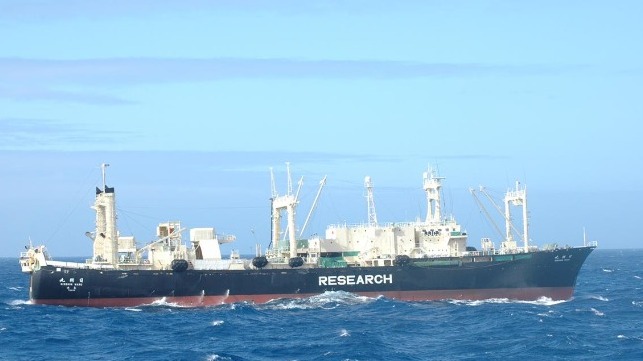Japan's Last Whaling Mother Ship May Cost Too Much to Replace

Anti-whaling activists are pleased that Japan's last whaling mothership operator is ordering a replacement vessel - not because they expect it to succeed, but because they believe that the cost and debt load from the order will put the firm out of business.
Whale hunting in Japan is an unprofitable industry, and its range - which once reached as far as Antarctica - has been limited to Japanese home waters since the nation withdrew from the International Whaling Commission in 2018. The industry is now formally classified as a commercial fishery, not a research venture, and it is sustained by government payments of about $2 in subsidy for every $1 in sales to the public. Whale meat - known for its gamey, beefy flavor - is not popular in Japan, and it accounts for about one tenth of one percent of the nation's meat consumption, despite years of industy-backed promotional efforts.
About half a dozen inshore whaling boats and one whaling mothership pursue Japan's national quota for minke, sei and Bryde's whales. The quota is currently set at about 1,500 tonnes per year, and is based on the latest science for responsible management, according to Japan's Fisheries Agency.
Japan's leading whaling operator, Kyodo Senpaku, acknowledges that this volume is not enough to support a profitable industry without subsidies. Still, the company plans to invest $55 million - sourced from loans, crowdfunding and non-whaling charter missions - to buy a newbuild replacement for its aging mothership, the Nisshin Maru.
The Nisshin Maru is the last factory whaling ship in the world, and she has a storied history of confrontations with anti-whaling activists. She collided with the Greenpeace vessel Arctic Sunrise in 1999 and again in 2006, and she was allegedly in collision with the Sea Shepherd vessels Steve Irwin, Bob Barker and Sam Simon multiple times during her 2013 Antarctic campaign (along with her own refueling tanker, the Sun Laurel).
After three decades of whaling, Nisshin Maru is nearing the end of her service life, and Kyodo Senpaku wants to replace her with a new Antarctic-capable vessel. However, the firm is a loss-making enterprise, and its annual subsidies from the Japanese government have recently been replaced by a $9 million per year loan package. Nisshin Maru costs about $6-7 million per year to maintain, and the $55 million price of a newbuild - more than twice the annual sales turnover of the entire Japanese whaling industry - may pose a commercial obstacle if the quota and catch area are not increased.
"The number of people who eat whale meat in Japan is decreasing year on year, so it is no longer a viable business," anti-whaling activist Ren Yabuki of the NGO Life Investigation Agency told SCMP. "The government should not support the whaling industry with money from taxes because this is a business conducted by private companies who should survive on their own budgets, just like any other Japanese company."
But there is a non-commercial reason to keep a small whaling fleet, argues Kyodo Senpaku spokesman Konomu Kubo: whaling could maintain Japan's food security in times of scarcity, just like it did 70 years ago. Japan's industrial-scale whaling operations began as an emergency effort after WWII, when Gen. Douglas MacArthur proposed to use whale meat to fill a food shortage in occupied Japan. It worked, and whales provided low-cost protein to keep the nation fed in the post-war period. In the event of a similar food shortage in the future, Kubo told SCMP, Japan could once again turn to whales for sustenance if it maintains a small high-seas whaling fleet.
